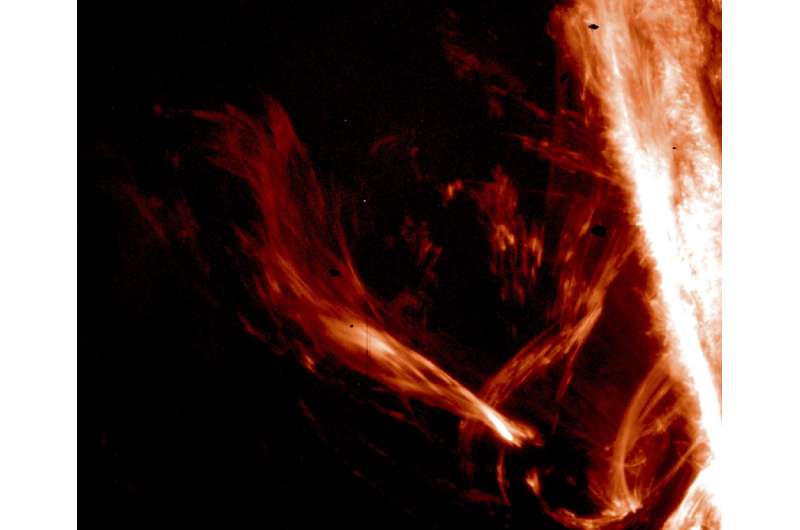First direct observation of elusive waves reveals energy channels in solar atmosphere

For the first time, torsional Alfvén waves have been directly observed in the solar corona by a team of researchers from the University of Oslo and the University of Warwick. The discovery sheds light on the origin of magnetic waves and their role in the heating of the sun's corona.
Just like a pond of water, the solar atmosphere, filled with magnetized plasma, can support a variety of waves. Purely magnetic waves, also known as Alfvén waves, were predicted in 1942 by Swedish plasma physicist Hannes Alfvén, who later received a Nobel prize in 1970.
Alfvén waves are thought to play an important role in the heating of the sun's outer atmosphere, the corona. The corona reaches temperatures of millions of degrees. However, the visible surface of the sun is much cooler, at temperatures of only 6000 degrees. Common sense suggests the temperature should decrease the further away we are from a warm object. This, however, does not apply in the solar atmosphere. Thanks to their properties, Alfvén waves are able to carry energy efficiently from the lower solar atmosphere all the way into the corona. In structures on the sun, they manifest as a torsional motion of the magnetic field in alternating directions—this is similar to the motion of rotating pendulum in an anniversary clock. They are, however, notoriously difficult to detect, because they can only be seen in solar spectra in the emission coming from atoms in the solar atmosphere. The wavelength of the emission is perturbed by the waves like a siren changing its pitch when it passes the observer. Up until now, it was unclear whether torsional Alfvén waves were present in the solar corona, or how they were generated.
Solar magnetic field is continuously twisted and braided by the dynamic motions in the lowermost layers of solar atmosphere. If such a twisted structure is destabilized, it can erupt and reconnect with the surrounding magnetic field through a process known as magnetic reconnection. The team of scientists led by Dr. Petra Kohutova from the University of Oslo (Norway) have managed to observe such an event occurring at the east solar limb in great detail. During the eruption, energy build up in the magnetic field was released into the corona, overshooting the magnetic field equilibrium and triggering a large-scale torsional Alfvén wave.
To analyze the event, the researchers combined the data from two NASA's space-based observatories: the Interface Region Imaging Spectrograph (IRIS) and the Solar Dynamic Observatory (SDO). They were able to recover information about the motion of the solar plasma during the eruption from the solar spectra and link it to the dynamics seen in imaging data. Combining both imaging and spectral signatures they have obtained a clear evidence for the generation of a torsional wave that carried the magnetic energy away from the reconnection site into the corona.
"In addition to having for the first time directly observed torsional Alfvén waves in the solar corona, we have also shown that magnetic reconnection can lead to generation of such waves," says Dr. Kohutova.
Since the lower solar atmosphere is filled with small-scale twisted magnetic structures, such wave generation mechanism is likely to be very common.
"This is an important discovery, because we can conclude that the ubiquitous reconnection events occurring in the solar atmosphere can excite Alfvén waves on global scales," continues Dr. Kohutova.
A large spatial and spectral resolution is however necessary for the telescopes to be able to detect such events. The 4-meter Daniel K. Inouye Solar telescope, the largest solar telescope in the world, recently built in Hawaii, might provide astronomers with the missing pieces to the coronal heating puzzle.
More information: P. Kohutova et al. First direct observation of a torsional Alfvén oscillation at coronal heights, Astronomy & Astrophysics (2019). DOI: 10.1051/0004-6361/201937144
Journal information: Astronomy & Astrophysics
Provided by University of Oslo




















